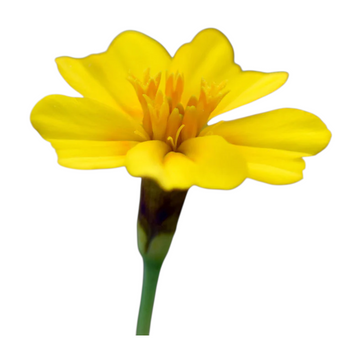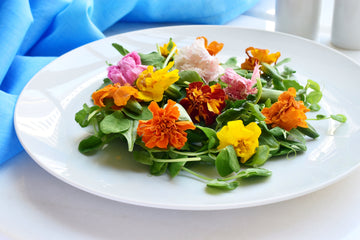Lemon Gem Marigold

Freshly Harvested

Non-GMO & Natural

Nutrient Dense

Trusted by Chefs
15 Seeds+
🌼 Lemon Gem Marigold Seeds
Tagetes tenuifolia
A burst of sunshine in bloom 🌞🍋, Lemon Gem Marigold is a compact variety that produces masses of small golden-yellow flowers with a refreshing citrus scent and flavor. Unlike common marigolds, this gem type offers edible petals with a zesty lemon note 🌿✨, making it a favorite of chefs, bakers, and mixologists. Hardy, floriferous, and pest-repelling 🌱🐜, it’s a triple-win plant: ornamental, culinary, and functional.
👅 Flavor Profile:
Bright lemon 🍋, tangy citrus 🍊, with subtle herbal spice 🌿.
🍴 Culinary Uses:
🥗 Sprinkle petals into salads for lemony zest and golden color
🧁 Decorate cakes, pastries & cookies with sunny edible blooms
🍸 Float petals in cocktails, syrups & shrubs for citrus brightness
🍵 Steep in teas or infuse vinegars for a refreshing tang
🥘 Add to rice or grain dishes for color + subtle citrusy lift
👨🍳 Chef’s Pitch:
Lemon Gem Marigold is the chef’s citrus-floral garnish 🌼👨🍳🍋. With its delicate golden blooms and lemony flavor, it delivers both beauty and taste to salads, desserts, and cocktails. Compact, prolific, and fragrant, it’s a must-have edible flower for creative kitchens.
🌱 Growing Notes:
🪴 Compact annual, 12–16” tall, bushy mounded growth
🌼 Masses of bright yellow edible blooms with citrus scent
⏱ Long bloom season: summer → frost
🌞 Thrives in full sun, drought-tolerant once established
🐝 Attracts pollinators & repels pests (especially aphids & nematodes)
✨ Quick Facts:
-
Latin Name: Tagetes tenuifolia (‘Lemon Gem’)
-
Habit: Annual, compact 12–16” tall
-
Flavor: Lemony, tangy citrus, herbal
-
Culinary Uses: Salads, teas, cocktails, cakes, rice dishes
-
Companion Planting: Pest deterrent + pollinator attractor

Lemon Gem Marigold

Let’s Manifest Beauty.
Edible Flowers that Smile.
Edible flowers are more than just decoration — they’re a chef’s secret for adding elegance, fragrance, and subtle flavor to a dish. From citrusy marigolds to honey-sweet alyssum and tangy begonias, these delicate blooms transform plates into experiences. Each petal offers color, aroma, and taste, turning simple ingredients into a culinary statement.

Flowers are here to stay
The Art of Garnishing with Edible Flowers
A garnish should do more than decorate — it should enhance. Edible flowers bring color, fragrance, and subtle flavor to the plate, turning simple dishes into memorable experiences. From delicate petals scattered across a salad to a single bloom crowning a dessert, flowers add elegance and elevate presentation in ways that engage every sense.
The Secret Ingredient Chefs Trust
Widely used in professional kitchens, microgreens enhance flavor profiles while adding nutrition and a striking visual appeal to everything from sandwiches to fine dining creations.
Frequent Asked Questions
Q: What are Microgreens?
Microgreens are young, tender plants harvested just after the first leaves develop. They’re packed with flavor, color, and nutrients, making them both delicious and healthy.
Q: Are microgreens really more nutritious than regular vegetables?
Yes. Research shows that microgreens can contain up to 40x more vitamins and antioxidants (like A, C, K, and E) compared to their mature counterparts.
Q: How do I use microgreens in my meals?
They’re incredibly versatile—use them as a garnish, in salads, on sandwiches, in wraps, smoothies, soups, or even as a centerpiece ingredient in gourmet dishes.
Q: How long do microgreens stay fresh?
Stored properly in a fridge, microgreens typically last 5–7 days. To keep them at peak freshness, store them dry in a breathable container.











